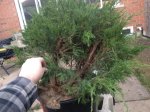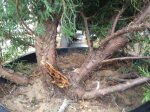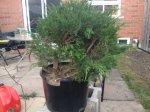Tim.E
Mame
Hey everyone,
I've got a question regarding the repotting of a big mint Julip juniper I plan on doing in spring. It is a well established nursery Juniper growing in some really poor clay/sand soil. I'm newer to juniper repotting and I'm unsure as to how hard I can go on it when it starts extending growth in spring. Can you bareroot em and prune aggressively seeing as they are foliage dependent? Any feedback would be great and I'll throw a picture up of the juniper later when I get home from work.
Thanks
Tim
I've got a question regarding the repotting of a big mint Julip juniper I plan on doing in spring. It is a well established nursery Juniper growing in some really poor clay/sand soil. I'm newer to juniper repotting and I'm unsure as to how hard I can go on it when it starts extending growth in spring. Can you bareroot em and prune aggressively seeing as they are foliage dependent? Any feedback would be great and I'll throw a picture up of the juniper later when I get home from work.
Thanks
Tim



